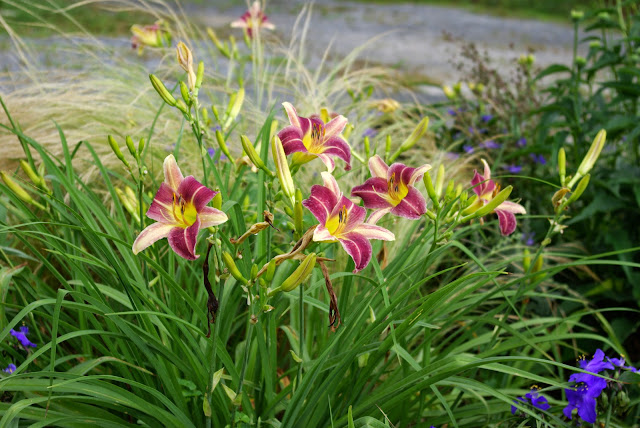There are no natives blooming here in late January. It's the middle of winter and cold and dreary, so this is no surprise. A Witch Hazel is in full bloom, but that is a seedling of 'Jelena', herself
Hamamelis x intermedia, a Chinese and and Japanese hybrid. So I went back into both the archives and future plans to look at Baptisia.
I love Baptisia. It's both a very beautiful plant and a survivor. Its only weakness is that voles love its thick roots. It's easy to get around the voles by planting Baptisia into 3 gallon pots sunk into the ground and mulching the surface with sharp gravel. The bottoms of the pots are cut out to allow the Baptisia roots to sink in deep. 3 gallon pots work because the roots go straight down. Voles won't dig very deep or in sharp gravel, and since voles will not chew through plastic and plastic buried in the earth lasts forever, this strategy has worked. If I didn't go to this trouble I don't think I'd have any Baptisia at all, and voles don't really trouble anything else besides this and Lespedeza.
The effect of Baptisia is ethereal in spite of its toughness. I have
Baptisia alba and
B. 'Purple Smoke' in the big perennial bed
as well as
Baptisia australis, whose color ranges from purple

to blue.

So, I decided to try some other types. This past fall I extended the bed beside the paddock to almost full length. Here is part of the bed from last spring, with 'Twilight Prairie Blues', a hybrid of
B. australis and
B. sphaerocarpa.
I remember thinking it might look good with
iris 'Beotie', if they would bloom together at the same time. Not sure they would, since Beotie is listing as an early bloomer.
I found this picture and realized I had completely forgotten that the flowers were originally a deep chocolatey purple with yellow edges, the typical advertisement color combination, before they faded to the smoky lavender pictured above. This will of course necessitate more iris and other companion plant research. :)
I also added 'Carolina Moonlight', a lovely hybrid of
Baptisia alba and
B. sphaerocarpa. Like 'Purple Smoke', this hybrid was selected by the late
Rob Gardner of the North Carolina Botanical Garden.
After reading in the Plant Delights catalog that
'Purple Smoke' is a hybrid of
Baptisia minor and alba, not australis and alba, and seeing
Baptisia minor in the catalog too, I was intrigued by this diminitive
B. australis lookalike.
Enter Prairie Moon Nursery, which sells a spectacular variety of seeds. In their catalog I saw listed the seeds of
Baptisia bracteata, minor, sphaerocarpa, and
tinctoria, as well as
B. alba and
australis. So a couple of years ago I ordered the seeds, started them last year, and put them in the new bed beside the paddock last fall.
I don't have any pictures of the new Baptisia since they won't bloom for another 2-3 years. I have this picture from the Sandhills section of the NC Botanical Garden, which I think is
B. sphaerocarpa.
Baptisia bracteata, commonly called Cream Wild Indigo, is a species of dry prairies and woodlands.
It's well-named, as the flowers are the color of blended butter and cream and nod gracefully.

Baptisia sphaerocarpa, one of the parents of both 'Carolina Moonlight'
and 'Twilight Prairie Blues', is another drought-tolerant species that
has round seed-pods, like cherries. Thus the scientific name sphaerocarpa.

image from Missouri Botanical Garden
Baptisia tinctoria looks like it has a somewhat softer yellow color than
B. sphaerocarpa.

If I don't like these seed-grown Baptisias and selected cultivars are better, I'll just take them out and put australis and alba in and maybe try some of the cultivars. All were easy to grow from seed, perhaps because the seeds came from Prairie Moon with a species-specific inoculum.
Below is a picture of another Baptisia hybrid at the NC Botanical Garden.
I don't think it's 'Twilight Prairie Blues' ~ the color looks too orchid
purple. Since Baptisias hybridize freely, the possibilities are almost endless... :)

Thank you
Gail for hosting Wildflower Wednesday!






































































